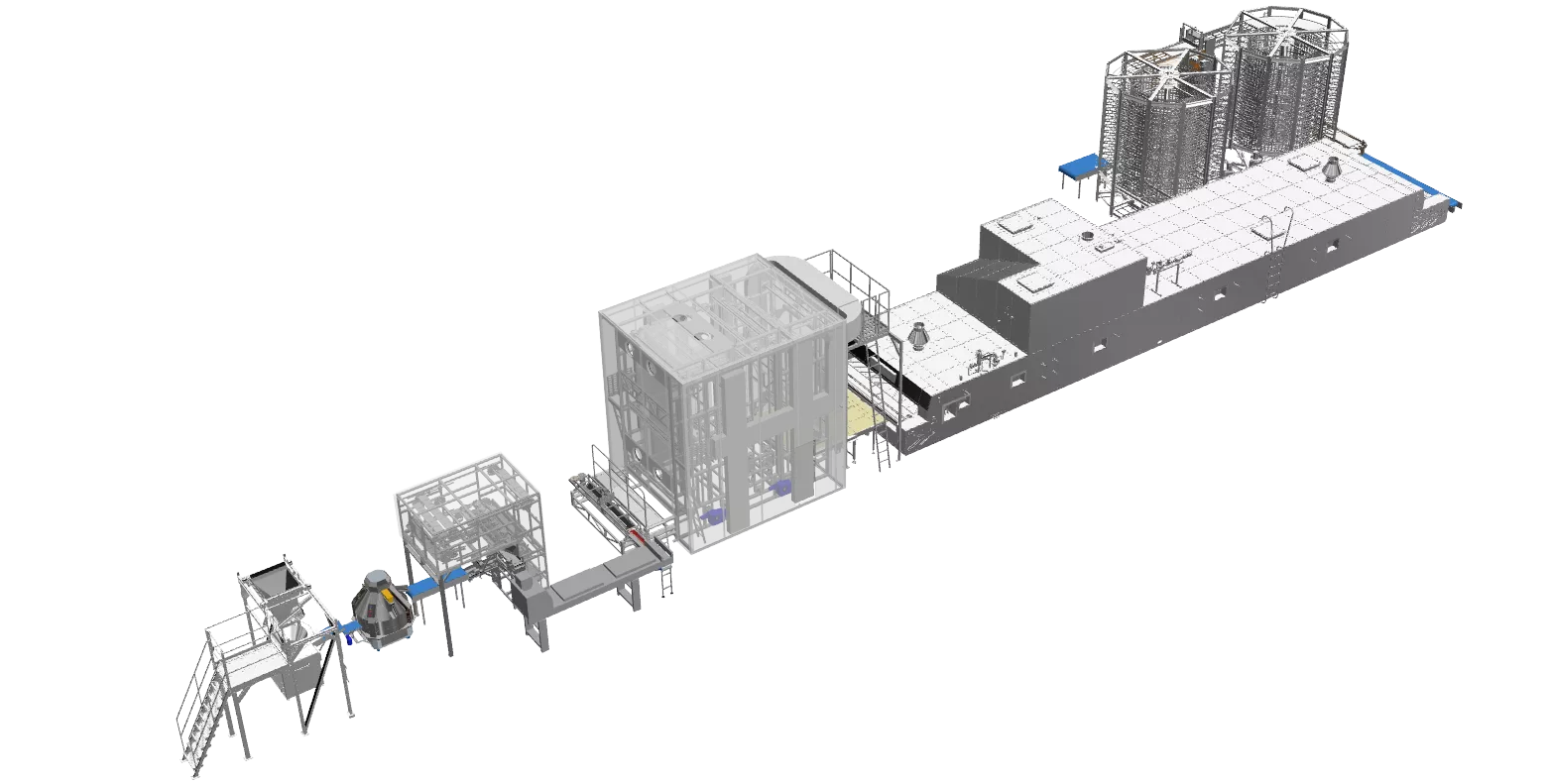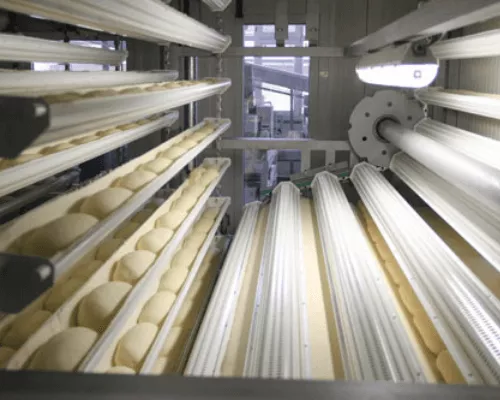Cultural customs and the specificities of individual markets determine whether the products need to be proofed in special proofing molds on swing trays, or in baskets, peelboards, or belts. The primary element that influences the structure of the final baked product is its orientation when transferred onto the oven conveyor belt.

Dělení těsta
Výběr vhodné děličky závisí především na požadovaném výkonu linky, typu a váhy výrobku. Od správné volby děličky se pak odvíjí také další složení linky, které se liší v případě výroby žitno-pšeničných nebo pšeničných chlebů. Synchronizace s celou linkou je zajištěna a ovládání je centralizováno na kontrolním panelu.
Tvarování
Složení tvarovací části se bude výrazně lišit u výroby žitno-pšeničných a pšeničných chlebů. Až na základě znalosti konkrétního výrobku je možné určit jaký vhodný typ vykulovače (pásový nebo kuželový), vyvalovače, rozvalovaní či předkynárny (přepadová nebo závěsová) bude použit.

Značení / nařezávání / posyp
Před vstupem do pece je možné linku doplnit o značení, podélné a šikmé nařezávání, a také zařízení na vlažení a posyp výrobků libovolným typem posypu. V závislosti na složitosti požadovaných řezů můžeme nabídnout mechanické zařízení nebo plně robotické řešení.

Popis...
Kynárna
Pro získání výrobků s požadovaným objemem, tvarem a vzhledem musí být velký důraz kladen na správnou volbu průběžné kynárny. Mezi další kritéria výběru patří prostorové možnosti pro umístění kynárny a také lokální tradiční způsob výroby, který musí být respektován i při průmyslovém pojetí výroby.
Více informací v samostatné sekci Kynárny.

Popis...
Popis...
Upon exiting the proofer, products are inverted by 180º, and continue under the scoring mechanism, through the seeding unit, and into the oven in this inverted position.
In this configuration, the products travel under the scoring mechanism, through the seeding unit, and into the oven without the need to invert them as they exit the proofer.
Selecting a suitable divider depends primarily upon the required performance capacity of the line as well as the type and weight of the product. This then influences the configuration of the rest of the line, which may vary, for example, between the production of rye/wheat or all-wheat bread. The entire line is synchronized, and is operated from a centralized control panel.

The configuration of the molding component of the line varies considerably between the production of rye/wheat and all-wheat bread. The choice of an appropriate rounder (belt or conical), molder (for either rye/wheat or all-wheat bread), and intermediate proofer (pocket or tray) is derived from the type of product the line be producing.

In order to achieve a product with the required dimensions, shape, and appearance, it is important focus on choosing the proper type of continuous proofer. Other deciding factors include spatial dimensions available for the installation of the proofer as well as the importance of respecting the local traditional manner of production, even in industrial bread production.

There are two basic methods of unloading products from the proofer. The first involves a gentle inversion of the products by 180º using a drum. This ensures a smooth transfer of the products to the conveyor in straight rows. The second manner consists of unloading the products directly onto the oven conveyor belt. Another option involves transferring products onto a conveyor system in front of the oven, which, just like drum unloading, also ensures straight rows through the use of speed synchronization. Choosing an appropriate method of unloading is based on the type of product and its scoring requirements.

Our lines can also be equipped with stamping and scoring units (horizontal or diagonal), as well as units for moistening and/or seeding with any type of topping prior to entering the oven. Based on the complexity of the scoring requisites, we offer both mechanical scoring units and fully-robotic options.


Once the products are proofed, they can be baked in a cyclothermic, electric, or thermal oil tunnel oven. We work with worldwide tunnel oven manufacturers, and together we have the ability to design the perfect solution for your bakery.

LS's manufacturing program also includes bread production lines using deck ovens. A wide-ranging product portfolio, insufficient space for a tunnel oven, or local customs are all possible reasons for choosing a deck oven over a tunnel oven. Today, the combination of an automated proofer and product positioning units suitable for deck oven use is a highly sought-after alternative to the traditional mode of production using tunnel ovens.
Our line allows for the products to be transferred between the proofer and the oven loading unit using LS's specialized transfer conveyor that sits upon a rail system that is fully synchronized with the entire line.

Spiral coolers involve either cooling in ambient air in situations where natural cooling is desired, or in an isolated chamber with a cooling unit if the final result of the cooling process necessitates a product of a specific temperature.

Just like spiral coolers, swing coolers also offer the options of ambient air cooling or cooling in an isolated chamber using a cooling unit if the final result of the cooling process necessitates a product of a specific temperature.
